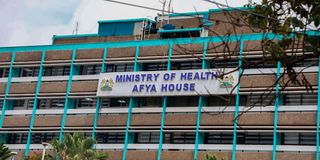The bipartisan awe and shock of Ruto’s unexpected anti-graft drive

Afya House in Nairobi, which houses the Ministry of Health headquarters. The government recently cracked down on corruption in the Health Ministry and the Kenya Medical Supplies Authority, to the surprise of many.
Many Kenyans may seem okay at first glance, yet deep down they are smarting from a devastating admixture of shock, disillusionment and a measure of stunned perplexity.
It would be lovely to impute the entirety of these symptoms to Azimio la Umoja’s righteous bubble of relentless pontification and polemic, but that would hardly be fair.
The truth is that the uneasy suspense that presently characterises public discourse is the unmistakable effect of bipartisan astonishment. The reverberations of this particular unexpected development have surged forcefully and expansively across the aisle.
It is true that for decades now, political forces arrayed against William Ruto found common cause in profiling him as an incurably corrupt, and irredeemably cynical powerbroker whose sole ambition, they said, was to establish Kenya as an official ‘kleptocracy’.
His bitterest critics propounded this with a desperate conviction, and the entire ecosystem of anti-Ruto strategists, commentators, analysts and mobilisers embraced Ruto’s putative corruption as an article of faith.
Bilious onslaughts
It is also true that as president, Uhuru Kenyatta’s bilious onslaughts on his deputy were premised on the expectation that corruption allegations would automatically legitimise the campaign to unconstitutionally dislodge him.
Kenyatta’s cynical appeals to integrity and sly pretence of fighting corruption earned him a fulsome endorsement from his arch-rival, Raila Odinga, insofar as fighting corruption was also understood to exclusively mean Ruto’s political destruction.
It is the reason why the Handshake was opportunistically sanitised as a high-minded anti-corruption coalition, and also why the BBI incorporated proposals to marginalise Ruto and consolidate an autocratic looting machine under the ironic pretext of combating corruption.
The strategic design of Azimio’s presidential campaign was undermined by the hubris conferred by the imagined potency of Kenyatta’s incumbency, legacy and administrative bandwidth. It was also severely encumbered by complacency arising from the expectation that a performative anti-corruption posture, combined with the sedimentary accretion of allegations of corruption against Ruto, would make the presidential election a ‘no contest’.
A tremendous cottage industry of anti-Ruto narrative fabricators dedicated to the industrious contrivance of specious corruption allegations and other vexatious interventions has entrenched itself in the national discourse.
A lot of what is taken for an incontrovertible fact is nothing more than the infinite recursion of calumnies painstakingly assembled by this industry to confer the illusory weight of factual authority to utter figments.
Even though the industrious profiling was premised on deception and mischief, it nevertheless empowered many adversaries with the necessary confidence to oppose Ruto, while driving legions of his supporters into irascible defensiveness and strategic aversion to any discourse bout integrity and corruption.
Legitimate resistance
The Hustler Nation’s legitimate resistance to the weaponisation of anti-corruption to deliver politically strategic outcomes made it irresistible to all who had fallen afoul of the justice, law and order sector, regardless of political pedigree and evidentiary standing.
This produced the unintended consequence of establishing a political twilight zone of tacit tolerance for corruption right inside the Hustler Nation campaign.
Understandably, therefore, it was taken for granted that as president, Ruto would condone corruption, if not outright abet it, as a bipartisan expectation that defined the motivations and actions of many, but not all notable players.
This is why the decisive response to corruption allegations at the Ministry of Health and the Kenya Medical Supplies Authority distressed and disorientated many. A narrative that had been politically institutionalised to define the expectations of many serious actors in both the public and private domain, was overturned unceremoniously and without warning. A lot of commentators on each side of our politics are in disbelief and denial.
Consequently, many arrangements, deals and rackets which should routinely proceed to fruition as a matter of notorious ‘tenderpreneurial’ course of business, are suspended in agonising abeyance.
Wheeler-dealers
Nefarious executives, wheeler dealers, brokers, politicians and civil servants are scanning their operating environment with tremendous anxiety, evaluating their position against the implications of a totally unexpected turn of events.
Denial counsels that this is just an anomaly, and matters will return to a corrupt normal in due course, while prudence suggests that there might be more where the Kemsa-Afya House thunderbolt came from.
Obviously, future events will help clarify the President’s philosophy, to the detriment of some untouchable potentates, and the delighted surprise of the moment.
Adverse profiling by political opponents may be agonising, yet it is to be expected and must be managed as a feature of hyper-competitive democratic political practice.
Permitting such profiling to condition the expectations, motivations and actions of functionaries within the administration can be nothing except desperate ignorance, cruel cynicism or the rankest treachery imaginable.
This is not intended to warn, teach or advise anyone on any matter whatsoever. The sole objective is to explain the loud silence and profound perplexity in our governance and anti-corruption spaces. That was not expected, and now everyone rightly wonders: how come?
Mr Ng’eno is an Advocate of the High Court of Kenya.





